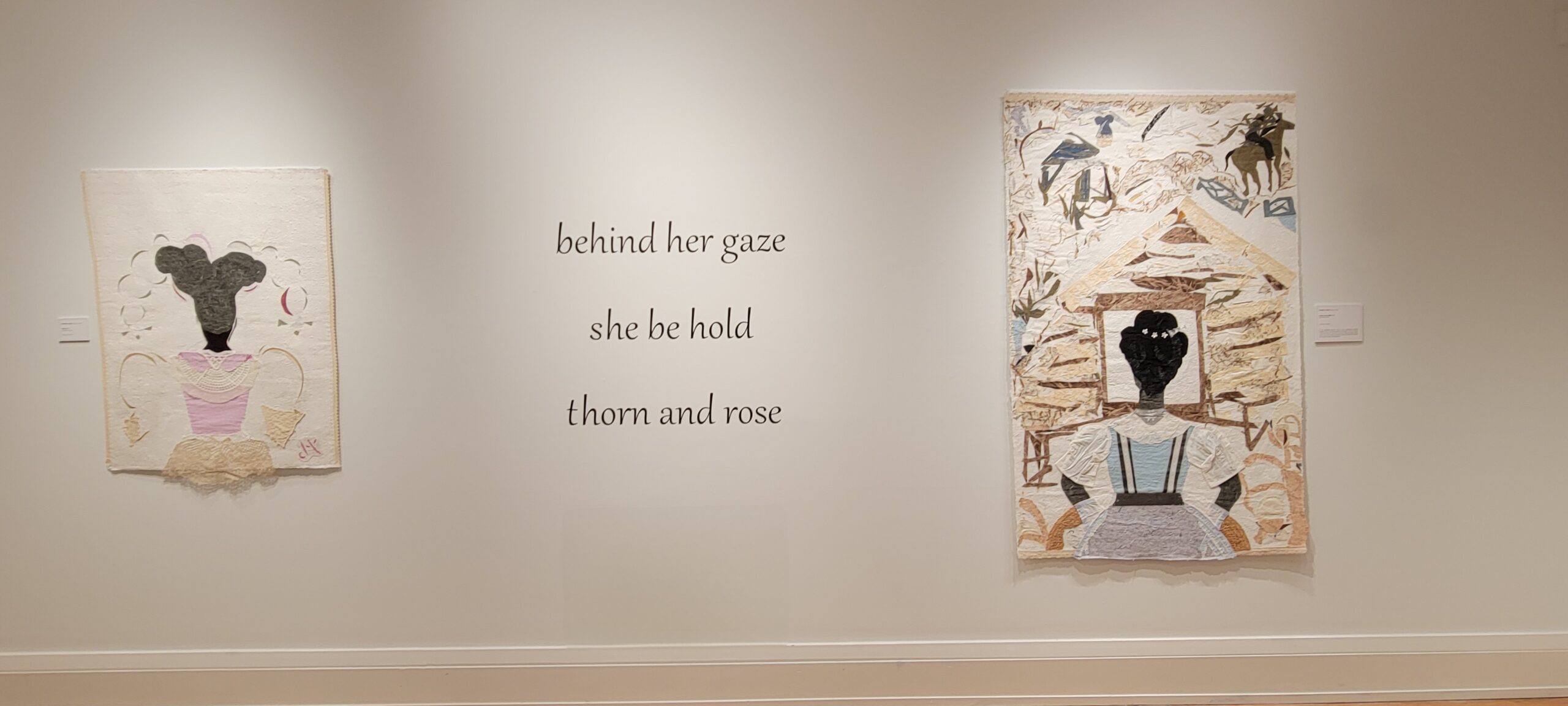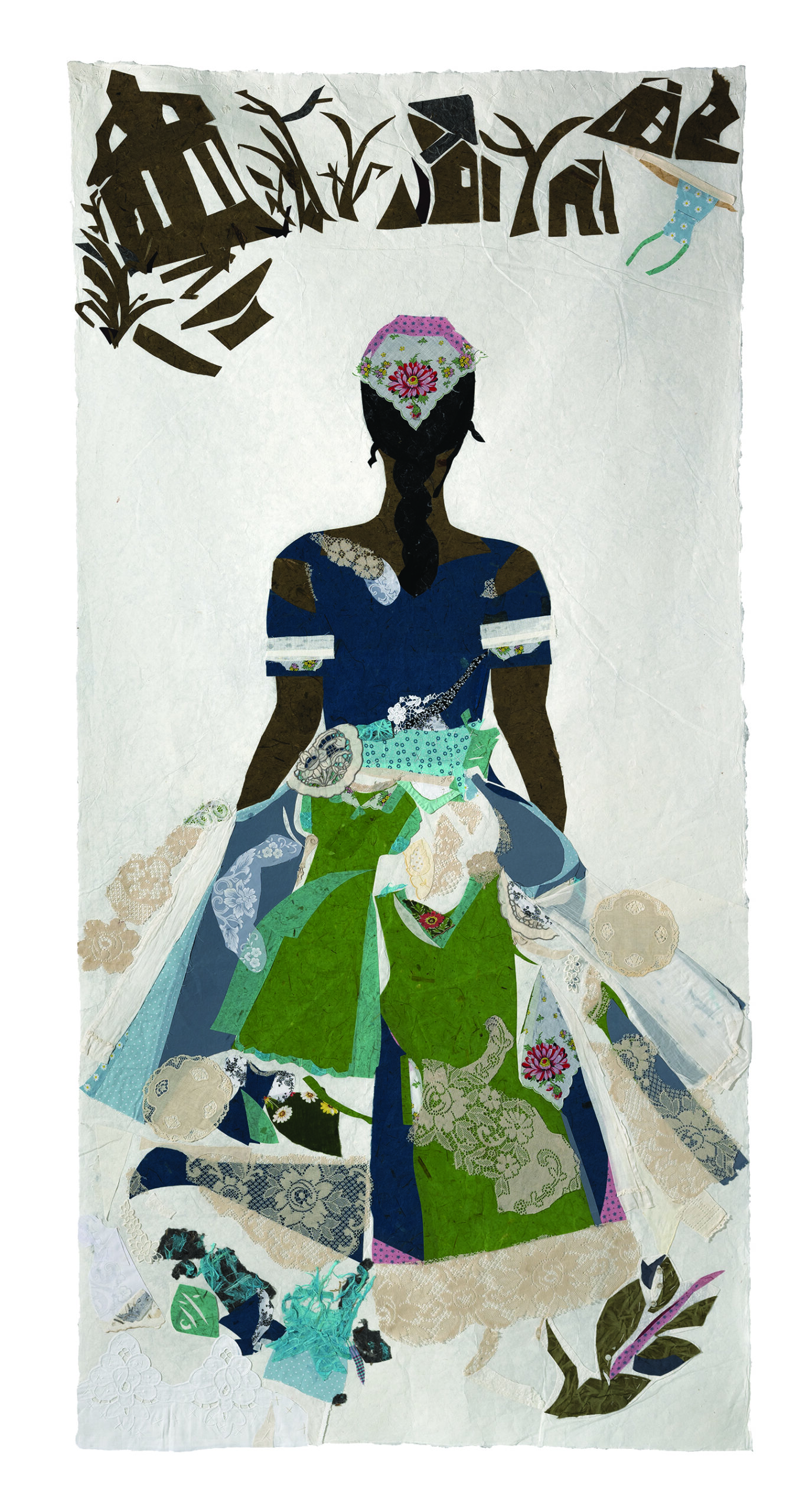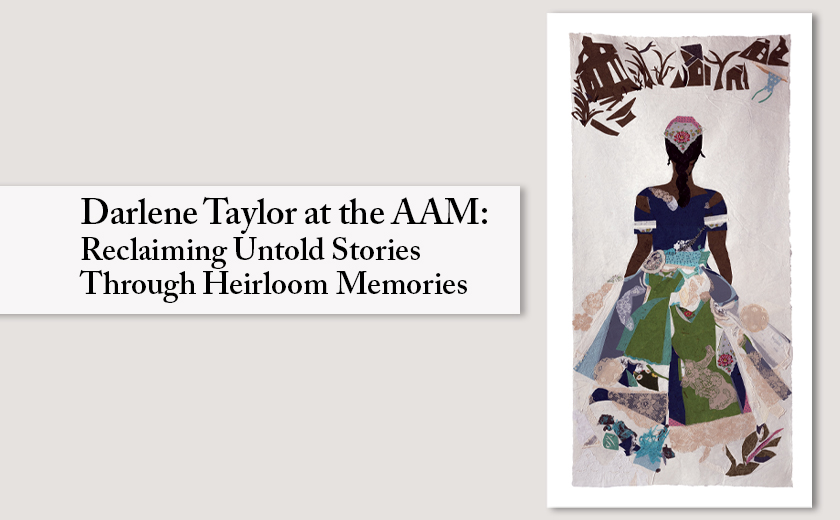 Currently on view through July 14th at the Academy Art Museum (AAM) is “Heirlooms,” – a profound and meaningful mixed media series by multidisciplinary artist Darlene Taylor. The collages incorporate vintage linens, laces, cottons, and buttons passed down from mother to daughter and friend to friend over generations. But Taylor doesn’t merely gather these textiles as historical artifacts. Through layering, stitching, and a poet’s lyrical touch, she weaves them into powerful artistic narratives that reclaim the inner lives of Black women so often omitted from the historical record.
Currently on view through July 14th at the Academy Art Museum (AAM) is “Heirlooms,” – a profound and meaningful mixed media series by multidisciplinary artist Darlene Taylor. The collages incorporate vintage linens, laces, cottons, and buttons passed down from mother to daughter and friend to friend over generations. But Taylor doesn’t merely gather these textiles as historical artifacts. Through layering, stitching, and a poet’s lyrical touch, she weaves them into powerful artistic narratives that reclaim the inner lives of Black women so often omitted from the historical record.
 Taylor’s artistic journey was inspired by the question: what stories lie within the silent gazes of Black women captured in 19th-century photographs? She felt drawn to uncovering the untold narratives of these women, whose voices had long been muted by history. “I look at those images of Black women, and I think about that moment of them standing still, sitting still, and I wonder, what does she feel? What does she think of the events happening in the world around her? I wanted to explore that through language and also through something very near and dear to me, something shared from mother to mother: stitch work. I wanted to put my hands on it.”
Taylor’s artistic journey was inspired by the question: what stories lie within the silent gazes of Black women captured in 19th-century photographs? She felt drawn to uncovering the untold narratives of these women, whose voices had long been muted by history. “I look at those images of Black women, and I think about that moment of them standing still, sitting still, and I wonder, what does she feel? What does she think of the events happening in the world around her? I wanted to explore that through language and also through something very near and dear to me, something shared from mother to mother: stitch work. I wanted to put my hands on it.”
The ensuing collages were influenced not only by the photographs and her familial tradition of craftsmanship but also by found items from historical excavations, such as those commissioned by AAM at the former home of Henny and James Freeman – one of the earliest documented free Black land-owning families in the area dating back to 1787. “History, as a muse, points me in a direction,” Taylor said. “As I look at a historical document, as I look at photographs, I wonder how that person sits inside of a history? What about her innermost thoughts as society’s upheavals swirled around her?”
 The exhibition’s textile montages are Taylor’s ways of trying to answer some of those questions. The figures are on backgrounds of collaged paper, stitched linens, and stuck buttons and beads. “Frequently, I find that there are photographs of women where there’s much more detail about the furniture…about the lace someone in the photograph was wearing – maybe even the paint colors in the room, but nothing about that woman,” Taylor said. “And I wonder about her? What’s her story? What’s this moment? She has no agency in this space, and I want to explore places where her voice comes alive and her feelings are shared, expressed, and heard.”
The exhibition’s textile montages are Taylor’s ways of trying to answer some of those questions. The figures are on backgrounds of collaged paper, stitched linens, and stuck buttons and beads. “Frequently, I find that there are photographs of women where there’s much more detail about the furniture…about the lace someone in the photograph was wearing – maybe even the paint colors in the room, but nothing about that woman,” Taylor said. “And I wonder about her? What’s her story? What’s this moment? She has no agency in this space, and I want to explore places where her voice comes alive and her feelings are shared, expressed, and heard.”
The “Heirlooms” series also exemplifies Taylor’s cross-disciplinary approach, blending visual art with poetic storytelling. Handwritten vignettes and verses intermingle with the mixed media textile compositions. We read snippets like “behind her gaze// she be hold// thorn and rose” on the wall between two life-sized figures, which are turned away from the viewer. This deliberate choice is a visual metaphor for the hidden histories and unspoken truths that linger beneath the surface. Taylor says, “I don’t want to objectify them by staring them in the face. I want to stand alongside and perceive the world from their vantage – to feel the textures and atmospheres they inhabited.”
An accompanying art book, Heirlooms, which Taylor crafted and can be found at AAM (or on her website), contains the series’ poems, photographs, and some earlier work. (By the way, Taylor is no stranger to the written word, as her writing has appeared in literary journals and anthologies).
Another striking feature of Taylor’s artwork is her invitation to the viewer to explore the feelings she’s portraying by both stepping back to take in some of the large-scale pieces and drawing near to examine the details and layered textures of the smaller, intricately stitched Victorian-type silhouettes.
 The 12-inch silhouettes are a bit of a departure from the larger eight-foot pieces as they were put together at the bedside of Taylor’s ill mother, taking form as “silent dialogues” with the fading matriarch. “As I was sitting with my mother, I was contemplating, what would I say to these mothers? My mother had dementia. So I asked her questions, and sometimes I got answers. Sometimes I got silence.” In a way, these smaller figures are a tribute to the fragility of collective memory.
The 12-inch silhouettes are a bit of a departure from the larger eight-foot pieces as they were put together at the bedside of Taylor’s ill mother, taking form as “silent dialogues” with the fading matriarch. “As I was sitting with my mother, I was contemplating, what would I say to these mothers? My mother had dementia. So I asked her questions, and sometimes I got answers. Sometimes I got silence.” In a way, these smaller figures are a tribute to the fragility of collective memory.
Something else that Taylor said she learned from her mother is a profound reverence and insistence on “tending the graves” of those who came before and preserving what fragmented testimonies endure. A particularly haunting anecdote involved discovering an unmarked cemetery with one small gravestone bearing only the chiseled word “MOTHER.” “I thought that was so powerful,” she said. “This woman is clearly loved by her children. But still, I wondered, what’s her name? When did she go? When did she come here? What more is there about her that I could know? I think about mothers, I think about that tombstone, and just what it means to be remembered, and what it means to have that absence.” The experience inspires her.
And so “Heirloom” continues to grow. “I’ve started thinking more about the textiles in those domestic spaces. So, in addition to the cloth that pressed against those mothers, the cloth they held in their hands, the cloth they wrapped their babies in, I’m also thinking about the fabrics inside the chairs, the wallpapers or wall coverings, the rugs beneath their feet. And I’m thinking about how that also expands the story of her interior life and what she must have felt.”
Just as Taylor is moved by the work she touches, so she invites the viewer to touch – no, not the exhibits – a piece of the fabric that once made up a life. It is situated at the end of the exhibit and was a powerful way to leave, becoming more aware of the importance of preserving the past and that stories can be found even in the smallest scraps of material.
Heirlooms by Darlene Taylor is on display at the Academy Art Museum through July 14, 2024.
More about the artist can be found on: https://darlenertaylor.com/



Write a Letter to the Editor on this Article
We encourage readers to offer their point of view on this article by submitting the following form. Editing is sometimes necessary and is done at the discretion of the editorial staff.